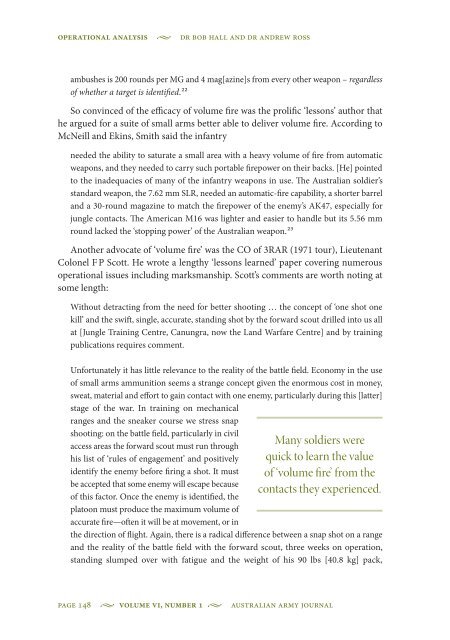Infantry Marksmanship and Combat Effectiveness ... - Australian Army
Infantry Marksmanship and Combat Effectiveness ... - Australian Army
Infantry Marksmanship and Combat Effectiveness ... - Australian Army
Create successful ePaper yourself
Turn your PDF publications into a flip-book with our unique Google optimized e-Paper software.
Operational Analysis • Dr Bob Hall <strong>and</strong> Dr Andrew Ross<br />
ambushes is 200 rounds per MG <strong>and</strong> 4 mag[azine]s from every other weapon – regardless<br />
of whether a target is identified. 22<br />
So convinced of the efficacy of volume fire was the prolific ‘lessons’ author that<br />
he argued for a suite of small arms better able to deliver volume fire. According to<br />
McNeill <strong>and</strong> Ekins, Smith said the infantry<br />
needed the ability to saturate a small area with a heavy volume of fire from automatic<br />
weapons, <strong>and</strong> they needed to carry such portable firepower on their backs. [He] pointed<br />
to the inadequacies of many of the infantry weapons in use. The <strong>Australian</strong> soldier’s<br />
st<strong>and</strong>ard weapon, the 7.62 mm SLR, needed an automatic-fire capability, a shorter barrel<br />
<strong>and</strong> a 30-round magazine to match the firepower of the enemy’s AK47, especially for<br />
jungle contacts. The American M16 was lighter <strong>and</strong> easier to h<strong>and</strong>le but its 5.56 mm<br />
round lacked the ‘stopping power’ of the <strong>Australian</strong> weapon. 23<br />
Another advocate of ‘volume fire’ was the CO of 3RAR (1971 tour), Lieutenant<br />
Colonel F P Scott. He wrote a lengthy ‘lessons learned’ paper covering numerous<br />
operational issues including marksmanship. Scott’s comments are worth noting at<br />
some length:<br />
Without detracting from the need for better shooting … the concept of ‘one shot one<br />
kill’ <strong>and</strong> the swift, single, accurate, st<strong>and</strong>ing shot by the forward scout drilled into us all<br />
at [Jungle Training Centre, Canungra, now the L<strong>and</strong> Warfare Centre] <strong>and</strong> by training<br />
publications requires comment.<br />
Unfortunately it has little relevance to the reality of the battle field. Economy in the use<br />
of small arms ammunition seems a strange concept given the enormous cost in money,<br />
sweat, material <strong>and</strong> effort to gain contact with one enemy, particularly during this [latter]<br />
stage of the war. In training on mechanical<br />
ranges <strong>and</strong> the sneaker course we stress snap<br />
shooting: on the battle field, particularly in civil<br />
access areas the forward scout must run through<br />
his list of ‘rules of engagement’ <strong>and</strong> positively<br />
identify the enemy before firing a shot. It must<br />
be accepted that some enemy will escape because<br />
of this factor. Once the enemy is identified, the<br />
platoon must produce the maximum volume of<br />
accurate fire—often it will be at movement, or in<br />
Many soldiers were<br />
quick to learn the value<br />
of ‘volume fire’ from the<br />
contacts they experienced.<br />
the direction of flight. Again, there is a radical difference between a snap shot on a range<br />
<strong>and</strong> the reality of the battle field with the forward scout, three weeks on operation,<br />
st<strong>and</strong>ing slumped over with fatigue <strong>and</strong> the weight of his 90 lbs [40.8 kg] pack,<br />
page 148 • Volume VI, Number 1 • <strong>Australian</strong> <strong>Army</strong> Journal

















